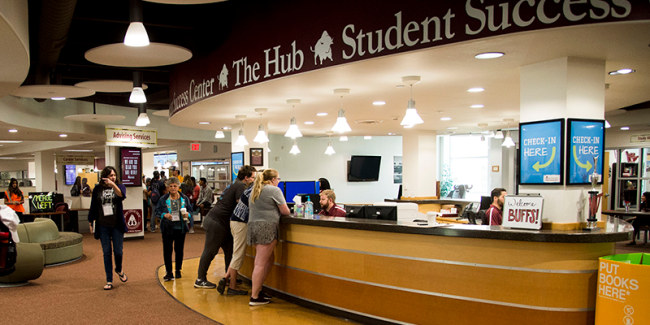You have /5 articles left.
Sign up for a free account or log in.

West Texas A&M University
A few years ago, Walter V. Wendler was at a high school near West Texas A&M University, where he serves as president.
The assistant principal told him about a student who would succeed if admitted to West Texas A&M but who was convinced “she wouldn’t have a chance” of getting in. Wendler met the student and reviewed her high school transcript. He admitted her on the spot, and she enrolled at WT, as those at the campus call it.
That experience led to the creation of a program in 2018. Under the program, principals at 137 high schools in or near the Texas Panhandle are invited each year to nominate five students for automatic admission to WT. An admissions officer reviews their transcripts, their test scores (for those who have them) and their class rank. Then they are usually admitted (Wendler said that in one case a student was told to enroll first at a community college). He stressed that he’s in a part of the country with many small high schools, which allows the principals to truly know their students.
WT has received 972 nominations of students and has enrolled 234 students through the system. He has not studied the decisions of those who don’t enroll. He plans to study how the students who enroll are doing, compared to students admitted regularly, but he says that anecdotally, they appear to be doing as well or better.
“There’s this triangulation going on,” said Wendler. “We commit to the principals. The students are burdened to perform because of this.”
He said he’s mentioned the idea to other university presidents and got no interest. “They asked about quality control,” he said.
But those universities, like his own and like most colleges, admit most of their applicants. WT rejects only about 25 percent of its applicants.
“We put entirely too much stock in measurement” as opposed to trusting principals, Wendler added.
The Picture Over All
What makes Wendler’s experience notable is that a number of colleges and businesses are experimenting with direct admissions, in which students don’t officially apply to a college but are admitted nonetheless. (None of the colleges are yet using the new systems to admit most students.)
Last month, Inside Higher Ed wrote about Concourse, a company that started with international students but last year broke into the market of American students, focusing on Chicago. Its focus in the United States has been on low-income students. In the next year, it will expand to seven regions: New York City, Philadelphia, Minneapolis–St. Paul, Dallas, Houston and Atlanta (while keeping Chicago). In each of those areas, Concourse will identify colleges that serve low-income students and college counselors who will certify the accuracy of what students put in their profiles. The students will not apply to colleges, but they will be admitted.
Last week, Inside Higher Ed wrote about Sage Scholars, which this fall will offer its members the chance to view profiles and to offer admission to students.
In all the cases (and those discussed later in this article), the colleges involved are typical colleges, public and private, in that they admit most applicants. Most are not well-known nationally and recruit primarily from their home states. There are arrangements that are singular, that involve a state or those that involve businesses. But what they have in common is a belief that the admissions system currently used by most colleges was designed for the colleges at the upper end of the prestige ladders (public and private). And they are asking who gains by putting all students through an arduous process.
Public-Private Effort in Minnesota
In Minnesota this fall, the state’s Department of Higher Education is arranging for admissions to be done differently for students at 50 high schools in the state. The students will be given the chance to opt in to the system. Those that agree will have their junior year grades put in a profile. Then some 40 colleges will have the chance to admit them. The colleges can stipulate a grade point average range that they want, or they can search by geographic area in the state. Colleges that want may admit the students.
Colleges are not being forced to participate, and some are staying out of the program, at least for its first year. Carleton College and Macalester College are two of the state’s private colleges that recruit nationally and are competitive with admissions. They are not participating.
At the University of Minnesota, Brad Robideau, a spokesman, said, “Three of those campuses are good fits for this pilot—Duluth, Crookston and Morris—and are participating. The Twin Cities campus uses a holistic review approach, which considers a number of factors for admissions. We will assess the pilot and align on how we can best serve academically prepared students.”
Many other colleges are jumping in.
Take Augsburg University. Each year it admits about 2,500 students for a freshman class of 600. It has been achieving good enrollment numbers in recent years. Ninety percent are from Minnesota.
But Robert Gould, Augsburg’s vice president for strategic enrollment management, said he would rather change the system of admissions than just tinker with what they have now.
Under the new system, he hopes to have admissions decisions (for those in the new program) all done by October and to have aid packages all worked out by December. “Part of the mission here is supporting democracy,” he said. “This is about sharing power.”
Admissions counselors will have more time to spend on outreach, on financial aid packages and on helping students rather than evaluating them, he said. “We are not considered a selective institution,” he said. “Nor do we want to be.”
When Idaho acted in a similar way—admitting all high school graduates to public colleges in the state in 2016—enrollment went up.
Common App
If many of the efforts to promote direct admissions are from those who want to shake up the system, one of them is from the Common Application, which to many people represents the establishment in admissions. After all, the Common App processes hundreds of thousands of traditional applications every year.
But the Common App is moving in the direction of direct admissions—for some. Six colleges and universities are participating this year. Common App is providing them with students from their states and regions. The students will have created an application through the Common App, but they may not have finished it beyond providing a transcript. But they will still receive admissions offers.
The six participating member institutions are Montclair State University, the University of Maryland Eastern Shore, Middle Tennessee State University, Fisk University, Marymount University (of Virginia) and George Mason University.
As of April 24, there were over 800 students who applied through the Common App direct admissions program. Of these students who applied through the program, 46 percent are first-generation students and 48 percent are underrepresented minority students. Students are still indicating whether they will enroll.
Niki Patel, who leads the effort, calls it “a really powerful tool for students, particularly those without support at home or in high school.”
Patel points to some of the responses the Common App has received:
- “I felt like I was wanted at a school after being rejected from my top two schools. It made me feel proud.”
- “I honestly felt some relief because it felt as though a lot of my accomplishments in high school were fully worth it. I honestly didn’t think that I was fully worth going to college, yet this showed me that I am somewhat prepared for my future.”
- “I felt more confident because a university was reaching out to me for the first time. It also made me feel more academically validated because it showed me that colleges were really interested in me.”




